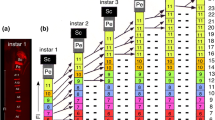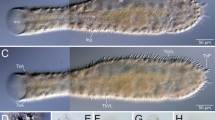Summary
Differentiated surface epidermal cells observed in the skin of tadpoles of Rana temporaria by electron microscopy have been identified with the Stiftchenzellen originally described by Kölliker in 1885. The cells have apical microvilli or a single apical projection and appear to have synaptic associations with nerve fibres in the epidermis. The distribution, dimensions and structure of the cells are in agreement with descriptions from light microscopy and are consistent with previous suggestions that the cells are sensory in nature. In addition, there are fine structural resemblances to the gustatory cells of fish and of amphibians which suggest that the Stiftchenzellen are chemoreceptors.
Similar content being viewed by others
References
Billett, F.S., Gould, R.P.: Fine structural changes in the differentiating epidermis of Xenopus laevis embryos. J. Anat. (Lond.) 108, 465–480 (1971)
Cambar, R., Marrot, B.: Table chronologique du développement de la grenouille agile (Rana dalmatina Bon.). Bull. Biol. Fr. Belg. 88, 168–177 (1954)
Carmignani, M.P.A., Zaccone, G., Cannata, F.: Histochemical studies on the tongue of anuran amphibian: I. Mucopolysaccharide histochemistry of the papillae and the lingual glands in Hyla arborea L., Rana esculenta L. and Bufo vulgaris Laur. Ann. Histochim. 20, 47–65 (1975)
During, M.V., Andres, K.H.: The ultrastructure of taste and touch receptors of the frog's taste organ. Cell Tiss. Res. 165, 185–198 (1976)
Graziadei, P.P.C., DeHan, R.S.: The ultrastructure of frogs' taste organs. Acta anat. (Basel) 80, 563–603 (1971)
Graziadei, P.P.C., Tucker, D.: Vomeronasal receptors in turtles. Z. Zellforsch. 105, 498–514 (1970)
Hirata, K., Nada, O.: A monoamine in the gustatory cell of the frog's taste organ. A fluorescence histochemical and electron microscopic study. Cell Tiss. Res. 159, 101–108 (1975)
Hirsch, J.G., Fedorko, M.E.: Ultrastructure of human leukocytes after simultaneous fixation with glutaraldehyde and osmium tetroxide and “postfixation” in uranyl acetate. J. Cell Biol. 38, 615–627 (1968)
Jande, S.S.: Fine structure of lateral line organs of frog tadpoles. J. Ultrastruct. Res. 15, 496–509 (1966)
Kölliker, A.: Stiftchenzellen in der Epidermis von Froschlarven. Zool. Anz. 8, 439–441 (1885)
Kolnberger, I.: Vergleichende Untersuchungen am Riechepithel, insbesondere des Jacobsonschen Organs von Amphibien, Reptilien und Säugetieren. Z. Zellforsch. 122, 53–67 (1971a)
Kolnberger, I.: Über die Zugänglichkeit des Interzellularraums und Zellkontakte im Riechepithel des Jacobsonschen Organs. Z. Zellforsch. 122, 564–573 (1971b)
Merkel, F.: Über die Endigungen der sensiblen Nerven in der Haut der Wirbelthiere. Rostock: Schmidt 1880
Meyer, M.: Kegel- und andere Sonderzellen der larvalen Epidermis von Froschlurchen. Z. mikr.-anat. Forsch. 68, 79–131 (1962)
Moser, H.: Ein Beitrag zur Analyse der Thyroxinwirkung im Kaulquappenversuch und zur Frage nach dem Zustandekommen der Frühbereitschaft des Metamorphose-Reaktionssystems. Rev. suisse Zool. 57 (Suppl. 2), 1–144 (1950)
Pevzner, R.A.: Electron microscopic investigation of receptor and supporting cells in taste buds of Rana temporaria. (in Russian). Tsitologia 12, 971–977 (1970)
Stensaas, L.J.: The fine structure of fungiform papillae and epithelium of the tongue of a South American toad, Calyptocephalella gayi. Amer. J. Anat. 131, 443–462 (1971)
Taylor, A.C., Kollross, J.J.: Stages in the normal development of Rana pipiens larvae. Anat. Rec. 94, 7–24 (1946)
Whitear, M.: Cell specialization and sensory function in fish epidermis. J. Zool. (Lond.) 163, 237–264 (1971)
Whitear, M.: The nerves in frog skin. J. Zool. (Lond.) 172, 503–529 (1974)
Whitear, M.: A functional comparison between the epidermis of fish and of amphibians. Symp. Zool. Soc. (Lond.). In press (R. Spearman, ed.). London: Academic Press 1976a
Whitear, M.: Apical secretion from taste bud and other epithelial cells in amphibians. Cell Tiss. Res. 172, 389–404 (1976b)
Author information
Authors and Affiliations
Additional information
Thanks are due to Dr. H. Fox for lending the micrograph of Figure 8
Rights and permissions
About this article
Cite this article
Whitear, Z. Identification of the epidermal “Stiftchenzellen” of frog tadpoles by electron microscopy. Cell Tissue Res. 175, 391–402 (1976). https://doi.org/10.1007/BF00218717
Accepted:
Issue Date:
DOI: https://doi.org/10.1007/BF00218717




